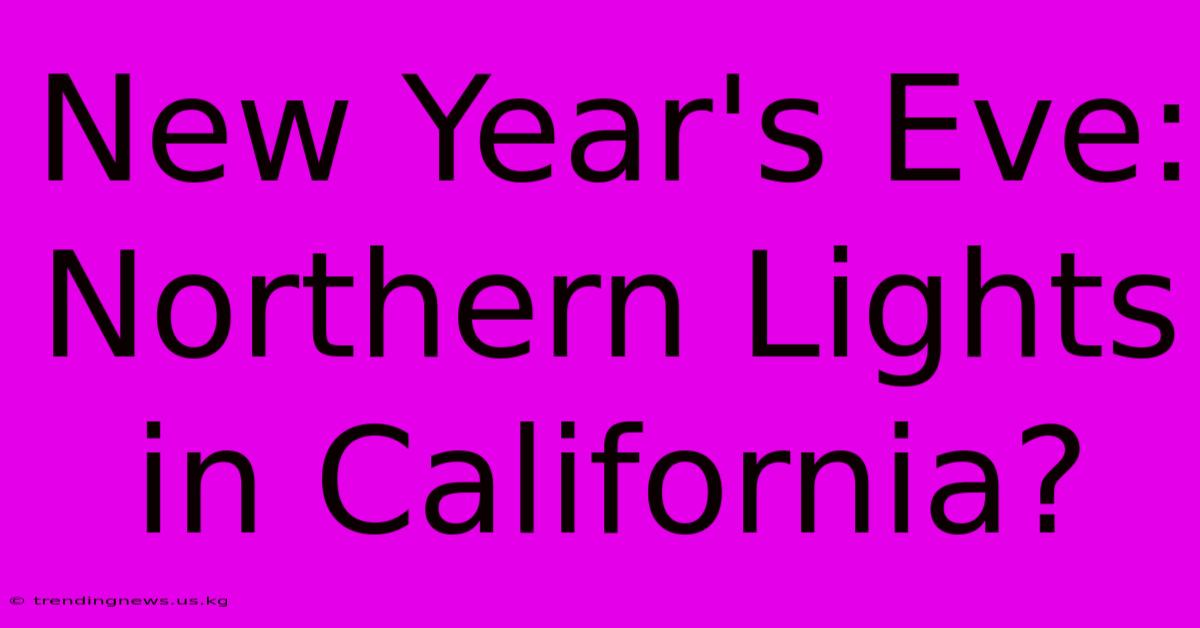New Year's Eve: Northern Lights In California?

Discover more detailed and exciting information on our website. Click the link below to start your adventure: Visit Best Website trendingnews.us.kg. Don't miss out!
Table of Contents
New Year's Eve: Northern Lights in California? A Magical (and Unlikely) Possibility
Dreaming of a New Year's Eve unlike any other? Imagine celebrating the start of a new year under the mesmerizing dance of the Aurora Borealis, the Northern Lights, right here in California. Sounds fantastical, right? While a California aurora viewing on New Year's Eve is highly improbable, it's not entirely impossible. Let's explore the possibilities and what you might need to do to increase your (slim) chances.
Understanding the Northern Lights
The Aurora Borealis is a natural light display in the sky, predominantly seen in the high-latitude regions (around the Arctic and Antarctic). These stunning displays are caused by charged particles from the sun colliding with atoms in the Earth's atmosphere. The intensity and visibility of the aurora depend on several factors, including solar activity, geomagnetic storms, and atmospheric conditions.
Why California is Unlikely (But Not Impossible)
California's location, far south of the typical auroral oval, makes it extremely unlikely to witness the Northern Lights. To see them, you typically need very dark skies, far from light pollution, and a strong geomagnetic storm. While California boasts some remarkably dark sky locations, the intensity of a geomagnetic storm required to push the aurora this far south is exceptionally rare.
Maximizing Your (Slim) Chances
While the odds are stacked against you, a few things can slightly improve your chances of witnessing this extraordinary event:
1. Monitor Solar Activity and Geomagnetic Forecasts
Keep a close eye on space weather forecasts. Websites and apps dedicated to aurora predictions can provide updates on solar flares and geomagnetic storms. A powerful enough storm could potentially push the aurora further south than usual. Look for terms like "Kp index" – a higher Kp index (above 7 or 8) indicates stronger geomagnetic activity.
2. Choose a Location with Minimal Light Pollution
Even with a strong geomagnetic storm, light pollution will significantly impact your ability to see the Northern Lights. Head to areas with minimal light pollution, such as:
- Eastern California deserts: Locations like Death Valley or Anza-Borrego Desert State Park offer exceptionally dark skies.
- High-altitude locations: Higher elevations provide clearer views of the horizon, potentially improving your chances.
- Remote coastal areas: Certain remote coastal areas along the northern California coast might offer slightly better viewing opportunities than inland cities.
3. Patience and Realistic Expectations
The most important factor is realistic expectations. Don't expect a vibrant, dazzling display like you'd see in Alaska or Scandinavia. If you're lucky enough to see any aurora activity in California, it will likely be very faint and subtle. You will need to give yourself plenty of time to adapt to the dark and allow your eyes to adjust fully.
Alternatives for a Magical New Year's Eve
While seeing the Northern Lights in California is a long shot, California offers plenty of breathtaking New Year's Eve experiences:
- Beach Bonfires: Celebrate the new year with friends and family on one of California’s stunning beaches.
- Mountain Top Views: Enjoy panoramic views of the city skylines with fireworks.
- Wine Country Celebration: Indulge in delicious wine and festive events in California's famous wine regions.
Conclusion: Hope Springs Eternal (But Check the Space Weather!)
While seeing the Northern Lights in California on New Year's Eve is a long shot, it's not impossible. By monitoring space weather forecasts, choosing a location with minimal light pollution, and managing your expectations, you can slightly improve your chances. Regardless of whether you catch a glimpse of the aurora, California offers numerous fantastic ways to celebrate the start of a new year. So, keep your eyes on the skies (and your space weather apps!), and have a happy and memorable New Year's Eve!

Thank you for visiting our website wich cover about New Year's Eve: Northern Lights In California?. We hope the information provided has been useful to you. Feel free to contact us if you have any questions or need further assistance. See you next time and dont miss to bookmark.
Featured Posts
-
New Years Eve Power Failure In Puerto Rico
Jan 01, 2025
-
What College Games Are On New Year S
Jan 01, 2025
-
New York Fire Victim Identified By Police
Jan 01, 2025
-
Uk Mens Basketball Live Stream And Radio
Jan 01, 2025
-
Alabama Football 3 Post Bowl Takeaways
Jan 01, 2025
